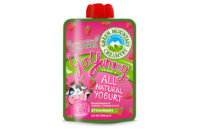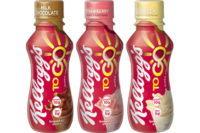
On The Go
by Shonda Talerico Dudlicek
Dairy products make perfect companions for busy consumers.
When it comes to portable
packaging, convenience is still king. But consumers don’t only
want dairy products they can take with them — they also want products
that will give them portion control.
“One of the hottest packaging trends right now
relates to health; not only do consumers want healthy snacks, they want
packaging to help them with portion control,” says Dennis Burian,
marketing director at Oshkosh, Wis.-based Curwood Inc. “That means
consumers want single-serving foods for ‘life on the go,’ as
well as for managing their diets, no matter where they happen to be
eating.”
While grab-and-go foods continue to gain popularity,
consumers are also eating more cheese, a trend that got a boost from the
now-cooled low-carb craze. “As consumers are becoming more health
conscious in general, portable cheese products are seen as nutritious
alternatives to traditional snack foods,” Burian says.
“Consumers are looking for high quality and variety in their snack or
convenience cheeses.”
For cheese to go, Curwood offers films for
individually wrapped string cheese, natural cut sticks and bars, and
multi-portion snacks in recloseable packaging and thermoformed trays and
flexible lids for snack kits.
“Consumers also want their convenience products
to taste just as fresh and flavorful as their full-size cousins, so
packaging with superior barrier protection is critical for these
products,” Burian says. Features such as easy-open open packages,
directional tear technology and recloseable sliders and zippers make
portable packaging easy to use.
Consumers are demanding more convenience.
“On-the-go-eating and drinking is a big trend,” says Bud Lane,
president of primary packaging at Pro Mach Inc., Loveland, Ohio. “You
have to balance out these benefits with cost. Consumers are willing to pay
a premium to a point, and only if it makes sense. For example, drinkable
yogurt would have been hard to imagine 20 years ago, but today it’s a
hot product in the market. A lot of this is common sense about how far
consumers are willing to delve out of their comfort zones with how we
consume products.”
Chilling Effect
Packaging consultant Aaron Brody says dairy processors
are restricted in their packaging options because their products require
refrigeration. “To make products [that stay fresh] in ambient
temperature and be credible to the consumer takes expensive machinery. Not
a lot of dairies want to spend that kind of money,” says Brody,
president and chief executive officer of Packaging/Brody Inc., Duluth, Ga.
“Single-serve bottles that have to be refrigerated, consumers are
afraid of these as portable packaging because of the refrigeration factor.
It can be done, but how do you convince the consumer?”
Brody says drinkable yogurt and tubular packaging for
yogurt have found success, as have cheese sticks and snacking cubes. He
also points to the fledgling Tetra Wedge Aseptic Clear, a clear aseptic
package that Tetra Pak introduced in Mexico last year and will offer in the
United States in 2006.
Aseptic technology allows for shelf stability without
preservatives. “The package also delivers clarity, play value,
novelty and fun appeal, as well as functionality and convenience,”
says Jeff Kellar, vice president of strategic business development, Tetra
Pak, Vernon Hills, Ill.
“There is a big opportunity for dairies and
brand owners to use the Tetra Wedge Aseptic Clear for existing products
like milk and smoothies and a variety of new dairy products,” Kellar
says. “The Tetra Wedge Aseptic Clear allows for both high- and
low-acid applications, making pouch-style, shelf-stable packaging a new
possibility for the dairy and soy industries.”
The package’s size and shape make it ideal for
kid beverages. Ergonomically, the Tetra Wedge Aseptic Clear was designed
with smooth sides and no sharp edges, and its slim 6.75-ounce design allows
small hands to easily handle the product, Kellar says.
With kids — and their parents — as the
intended audience for portable packaging, drinks have to be easy to handle
and hard to spill.
International Paper offers the Eco-Pak Plus with a
unique opening feature designed for straw puncture. The patent-pending
design is an embossed cross that allows for easier straw penetration
without leaking, says Judy Zeigler, marketing services manager, Evergreen
Packaging Equipment, Cedar Rapids, Iowa. This packaging is primarily used
in foodservice, including school lunch programs.
Stanpac Inc. is market testing its new Spoon’N
Lid premium frozen dessert package, which includes a 4-ounce paper/poly cup
with full-color lithography and ultraviolet varnish. The closure is a
plastic molded tamper-evident lid with a channel in the top of it for a
plastic molded pre-wrapped spoon. Over the top of the spoon is a paper poly
printed disc with graphics to match the cup and a window cut in the disc so
that the spoon is visible but held in place.
“I believe the consumer is looking for a package
that is safe with a tamper-evident feature that is visible at point of
purchase, shows the quality of the product inside with high-quality
graphics and is easy to consume with a spoon that looks and feels like a
spoon and goes down to the bottom of the package without getting your
fingers sticky,” says Murray Bain, vice president of marketing at
Stanpac, Smithville, Ontario, Canada.
As always, high-impact graphics are important so products capture
the attention of a time-pressed consumer.
“Society has become much more fast-paced in
recent years, and on-the-go consumption of beverages and food has increased
simultaneously,” Zeigler says. “Eye-catching graphics are
important for shelf appeal to make your products stand out.”
Lane agrees. “A lot of dairy products are being
done in full shrink sleeves and labels that offer 360-degree packaging.
We’ve noticed at Axon, our division that manufactures shrink labeling
and stretch-sleeving equipment, that even small companies are getting into
this trend, as it helps them compete against larger, more established
companies.”
Lane points to capping as another product feature.
“Capping is also getting more intricate,” he says. “The
ability to offer up different styles of caps is helping products
differentiate on the shelves.”
Lane notes that Pro Mach’s Fowler Products
division offers more complex machines to handle different styles of caps,
such as hinged caps. “And caps that can be quickly removed, with
a one-half or two-thirds turn to get the cap off quickly as opposed to two
or three turns like a carbonated soft drink,” he says.
Carried Away
Handles for carrying and bundling portable packaging
are becoming a differentiator as well. “A lot of dairy products are
shrink-wrapped together in bundles, but companies are also wanting the
ability to carry with a handle for both convenience as well as enhanced
marketing,” Lane says. “Our Roberts PolyPro division, which
manufactures handles and applicators for a wide range of beverages, has
noticed this is particularly true for companies selling through club
stores.” Dairy processors also want options for bundling items
together, whether that’s two-packs of milk gallons or six-packs of
single-serve drinks.
Zeigler says this type of bundle packaging is growing
in super stores and club and warehouse-type stores, especially in
extended-shelf life and aseptic products.
Dairy products, especially milk, have seen marked
growth in foodservice, says Chris Moore, vice president of foodservice
channel development, Dairy Management Inc., Rosemont, Ill.
“We are clearly seeing that McDonald’s,
Wendy’s and Culver’s continue to sell a lot of milk in plastic
bottles that meet the needs of their on-the-go customers. We’re also
encouraged by the evidence that other national and regional chains have
either completed or are establishing consumer test markets to sell milk in
plastic bottles with their customers,” Moore says.
Suppliers say another trend is to use less plastic in
the actual package for a lighter container. Whether this is due to the
after effects of Hurricane Katrina, which
stifled petroleum refining capacity and
affected resin production, or a new trend remains to be seen. Moore says
the spike in resin prices is temporary.
“What we hear from our foodservice partners is
recognition that resin prices — like all other raw materials costs
— are cyclical in nature and will ultimately be corrected by the
market,” Moore says. “The good news for the dairy industry and
for dairy consumers is that it’s not stopping them from moving
forward to an improved single-serve milk offering in a plastic
bottle.”
Shonda Talerico Dudlicek is a freelance journalist and a
former managing editor of Dairy Field.
Insights on Moving Milk
With families on the go in
this fast-paced world, portability is an important packaging feature.
Retailers and foodservice operators alike have noticed increased demand
among consumers for products that combine convenience and portability with
healthy attributes.
Tetra Pak examined this portability trend in its
just-released survey focusing on healthy kids’ beverages at
quick-serve restaurants and defining strategies to increase milk
consumption through this channel.
“In a business where 76 percent of milk drinkers
are kids under the age of 12 and the majority of milk is purchased in the
drive-through or carryout and then consumed in cars, function as a portable
package is crucial,” says Jeff Kellar, vice president of strategic
business development, Tetra Pak, Vernon Hills, Ill.
Kelton Research identified several key findings
regarding consumers’ preferences when it comes to portable packages
for dairy products and other healthy beverages. Through the study, Tetra
Pak was able to identify the following key trends in portable packaging:
Spill-proof: The
majority of milk is consumed in cars and moms want a drink their kids
can’t spill when they’re on the go. “Spill-proof”
capability matters most when picking a single-serve container for their
children, said 51 percent of parents surveyed, making it by far their No. 1
demand.
Safe outside the refrigerator: Parents want beverage containers that are safe without
refrigeration, which was named the second most important attribute. Nearly
20 percent said that was the most important consideration when picking a
single-serve container. The study showed 88 percent of parents end up
throwing out uneaten food or drinks every day because they have been out of
the fridge for too long.
Kid-friendly: Both
parents and kids want something that is kid-friendly – easy to open,
easy to hold. Kids like something that is uniquely “theirs”
that they feel is made especially for them.
“Not only is portable packaging important for
consumers, it is also important to retail and brand owners because it
allows them to provide consumers with what they are looking for and do it
in a convenient way,” Kellar says.
Kelton’s survey with 102 parents of children age
2 to 10 tested parents’ reactions to Tetra Pak’s Hershey Tetra
Brik Aseptic carton and the Horizon Organic Tetra Prisma Aseptic carton.
Parents commenting on the Hershey Brik container said they would definitely
buy a product in this packaging again for their child. Nearly nine of out
10 children were able to finish their beverage without spilling a drop on
themselves or their parents’ car when drinking from a Horizon Organic
Tetra Prisma container. At least 75 percent of parents said the Horizon
Organic Tetra Prisma package and 96 percent said the Hershey Brik was
“perfect for their child to drink on the go.”
$OMN_arttitle="On The Go";?>






